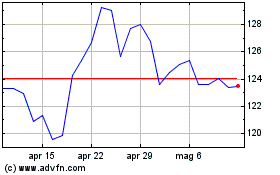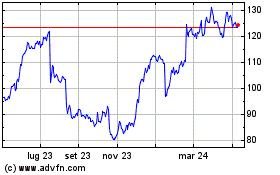US Lenders Take On Growing Segment Of First-Time Defaulters
16 Dicembre 2010 - 9:49PM
Dow Jones News
"You've successfully moved beyond bankruptcy and deserve a new
beginning," reads a credit-card mail offer from Capital One
Financial Corp. (COF).
The pitch, aimed at consumers who have suffered a serious
financial setback, underscores the challenge for U.S. financial
institutions such as Capital One, Bank of America Corp. (BAC) and
Wells Fargo & Co. (WFC): Faced with an erosion in profits
stemming from shrinking loan books, and new expansive rules curbing
income on credit and debit cards, lenders are exploring ways to
lend to a growing breed of borrowers with blemished credit.
A Deloitte Consulting LLP study published earlier this month on
first-time defaulters found 11% of 5,142 retail banking customers
suffered for the first time a significant financial setback in the
last two years, jeopardizing their access to credit from banks.
Not only are the numbers for these first-time credit offenders
too large for lenders to ignore, but also a portion still wield the
financial heft to take on credit. For U.S. consumers shut off from
credit, a new openness by lenders to first-time defaulters may open
up funding and a means to rebuild their fractured credit. Finding
ways to lend to those with blemished credit is also crucial to the
U.S. economy, with the hope that a pick-up in consumer spending
will spark job growth.
"The universe of people that are potential candidates for credit
isn't as big as it was before the recession. So what do you do? We
intend to deploy strategies to address that," said Jim Panzarino,
chief credit risk officer at Discover Financial Services (DFS). The
card issuer and payments processor reported Thursday an 8% decline
in net revenue from a year earlier, on an adjusted basis, to $1.6
billion. Its average credit-card loan balances dropped 6% to $44.7
billion during the same period.
Discover says it will soon start testing findings from its
research on means to gauge the creditworthiness of these first-time
defaulters. One element in its plan: it will double the number of
employees evaluating credit-card loan applications to 400 by the
end of 2011. In 2008, Discover had 10 such employees.
In every economic downturn, there are strapped borrowers, likely
struggling with unemployment, unable to fulfill their debt
obligations. Banks typically write off these loans as losses, and
cease lending to these customers. Some consumers eventually find
their way back onto lenders' books after rebuilding their credit
through, for instance, a secured credit card.
But this time around, many first-time defaulters are likely to
rebound more quickly from their setbacks than defaulters in the
past, lenders and analysts theorize, since the economic downturn
hurt so many people with otherwise sterling financial habits and
credit.
One subgroup in particular warrants attention. A large segment
of borrowers, known as "strategic defaulters," are walking away
from underwater mortgages, even though they have jobs, can afford
the debt payments and are current on other loans. Strategic
defaults totaled 19% of all mortgage delinquencies in the second
quarter of 2009, according to data from Experian-Oliver Wyman.
Credit-card lenders are differentiating between strategic
defaulters and "other borrowers who may be in trouble across all of
their loans," said Cristian deRitis, a director at Moody's
Analytics, an economics and credit consulting firm. "They are
continuing to lend, at higher rates of course, to those first-time
defaulters with otherwise good credit."
Some lenders are looking at the broader group of first-time
defaulters, while others are more focused on the subset of
strategic defaulters.
"We continue to analyze and reflect on the opportunity"
presented by strategic defaulters, said Mike McCoy, head of
consumer credit cards at Wells Fargo. The lender has yet to modify
its existing credit standards for these borrowers.
One in four offers for new credit cards are targeted at
non-prime consumers, says Andrew Davidson, senior vice president at
Mintel Comperemedia. In all, lenders mailed 1.2 billion credit card
solicitations in the third quarter, a three-fold increase from 391
million a year earlier, according to the firm, which tracks
credit-card mail offers.
A spokeswoman for Capital One said the credit card
lender-turned-bank has "a wide range of products for customers
based on their needs and profile to include those who may have
experienced financial challenges such as bankruptcies."
These explorations come as lenders look for ways to make new
loans to spur profits at a time when their loan portfolios continue
to shrink. Borrowers reduced their revolving credit lines--mainly
card balances--by about $5.6 billion in October from September,
according to the Federal Reserve. That's an annualized rate of
decline of 8.4%. Since the end of 2008, these balances have shrunk
by about $157 billion to $800.5 billion.
At the same time, lenders, still recovering from a massive spate
of defaults and delinquencies, have to steer clear of mistakes that
fueled recent losses.
"It's extremely important to piece together whether a first-time
default is an isolated incident with the consumer getting back on
his feet, or something more," said Chip Rossi, Bank of America's
head of credit and underwriting for deposits and card products.
-By Aparajita Saha-Bubna, Dow Jones Newswires; 617-654-6729;
aparajita.saha-bubna@dowjones.com
Grafico Azioni Discover Financial Servi... (NYSE:DFS)
Storico
Da Giu 2024 a Lug 2024

Grafico Azioni Discover Financial Servi... (NYSE:DFS)
Storico
Da Lug 2023 a Lug 2024
